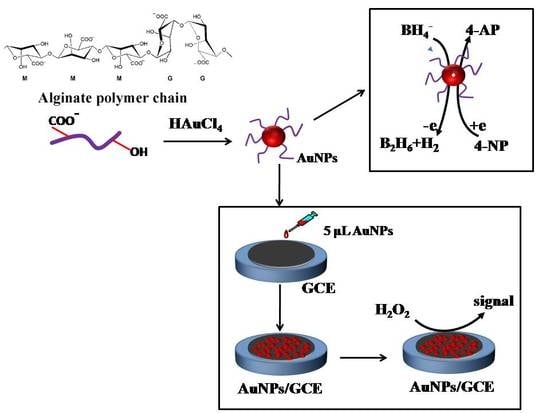Facile Synthesis of Gold Nanoparticles with Alginate and Its Catalytic Activity for Reduction of 4-Nitrophenol and H2O2 Detection
Abstract
:1. Introduction
2. Experimental Section
3. Results and Discussion
3.1. Effect of Reaction Parameters on the Synthesis of Gold Nanoparticles
3.2. TEM, XRD and DLS Analysis
3.3. Catalytic Activity Study of Gold Nanoparticles
3.4. Catalytic Activity Study of Gold Nanoparticles
O2 + 2e− + 2H+ → H2O2
4. Conclusions
Supplementary Materials
Acknowledgments
Author Contributions
Conflicts of Interest
References
- El-Naggar, M.E.; Shaheen, T.I.; Fouda, M.M.G.; Hebeish, A.A. Eco-friendly microwave-assisted green and rapid synthesis of well-stabilized gold and core-shell silver-gold nanoparticles. Carbohydr. Polym. 2016, 136, 1128–1136. [Google Scholar] [CrossRef] [PubMed]
- Talib, A.; Khan, M.S.; Gedda, G.; Wu, H.F. Stabilization of gold nanoparticles using natural plant gel: A greener step towards biological applications. J. Mol. Liq. 2016, 220, 463–467. [Google Scholar] [CrossRef]
- Anand, K.; Gengan, R.M.; Phulukdaree, A.; Chuturgoon, A. Agroforestry waste moringa oleifera petals mediated green synthesis of gold nanoparticles and their anti-cancer and catalytic activity. J. Ind. Eng. Chem. 2015, 21, 1105–1111. [Google Scholar] [CrossRef]
- Alex, S.; Tian, K.; Teng, S.; Siegel, G.; Tiwari, A. Simple and rapid green synthesis of micrometer scale single crystalline gold nanoplates using chitosan as the reducing agent. J. Cryst. Growth 2014, 406, 12–17. [Google Scholar] [CrossRef]
- Hwang, S.J.; Jun, S.H.; Park, Y.; Cha, S.H.; Yoon, M.; Cho, S.; Lee, H.J. Green synthesis of gold nanoparticles using chlorogenic acid and their enhanced performance for inflammation. Nanomed. Nanotechnol. Biol. Med. 2015, 11, 1677–1688. [Google Scholar] [CrossRef] [PubMed]
- Binupriya, A.R.; Sathishkumar, M.; Vijayaraghavan, K.; Yun, S.I. Bioreduction of trivalent aurum to nano-crystalline gold particles by active and inactive cells and cell-free extract of aspergillus oryzae var. viridis. J. Hazard. Mater. 2010, 177, 539–545. [Google Scholar] [CrossRef] [PubMed]
- Paul, B.; Bhuyan, B.; Purkayastha, D.D.; Dey, M.; Dhar, S.S. Green synthesis of gold nanoparticles using Pogestemon benghalensis(b) O. Ktz. Leaf extract and studies of their photocatalytic activity in degradation of methylene blue. Mater. Lett. 2015, 148, 37–40. [Google Scholar] [CrossRef]
- Sharma, B.; Purkayastha, D.D.; Hazra, S.; Gogoi, L.; Bhattacharjee, C.R.; Ghosh, N.N.; Rout, J. Biosynthesis of gold nanoparticles using a freshwater green alga, prasiola crispa. Mater. Lett. 2014, 116, 94–97. [Google Scholar] [CrossRef]
- Iravani, S. Green synthesis of metal nanoparticles using plants. Green Chem. 2011, 13, 2638–2650. [Google Scholar] [CrossRef]
- Singaravelu, G.; Arockiamary, J.S.; Kumar, V.G.; Govindaraju, K. A novel extracellular synthesis of monodisperse gold nanoparticles using marine alga, sargassum wightii greville. Colloids Surf. B Biointerfaces 2007, 57, 97–101. [Google Scholar] [CrossRef] [PubMed]
- Gonzalez-Ballesteros, N.; Prado-Lopez, S.; Rodriguez-Gonzalez, J.B.; Lastra, M.; Rodriguez-Arguelles, M.C. Green synthesis of gold nanoparticles using brown algae cystoseira baccata: Its activity in colon cancer cells. Colloids Surf. B Biointerfaces 2017, 153, 190–198. [Google Scholar] [CrossRef] [PubMed]
- Shi, G.; Li, Y.; Xi, G.; Xu, Q.; He, Z.; Liu, Y.; Zhang, J.; Cai, J. Rapid green synthesis of gold nanocatalyst for high-efficiency degradation of quinclorac. J. Hazard. Mater. 2017, 335, 170–177. [Google Scholar] [CrossRef] [PubMed]
- Ghodake, G.S.; Deshpande, N.G.; Lee, Y.P.; Jin, E.S. Pear fruit extract-assisted room-temperature biosynthesis of gold nanoplates. Colloids Surf. B Biointerfaces 2010, 75, 584–589. [Google Scholar] [CrossRef] [PubMed]
- Bagci, P.O.; Wang, Y.-C.; Gunasekaran, S. A simple and green route for room-temperature synthesis of gold nanoparticles and selective colorimetric detection of cysteine. J. Food Sci. 2015, 80, N2071–N2078. [Google Scholar] [CrossRef] [PubMed]
- Zafar, R.; Zia, K.M.; Tabasum, S.; Jabeen, F.; Noreen, A.; Zuber, M. Polysaccharide based bionanocomposites, properties and applications: A review. Int. J. Biol. Macromol. 2016, 92, 1012–1024. [Google Scholar] [CrossRef] [PubMed]
- Wang, C.Y.; Huan, K.S.; Yang, C.H.; Chang, W.R.; Grumezescu, A.M. A facile synthesis of gold nanoparticles-alginate composite spheres. Int. J. Latest Res. Sci. Technol. 2014, 3, 139–142. [Google Scholar]
- Qin, Y. Alginate fibres: An overview of the production processes and applications in wound management. Polym. Int. 2008, 57, 171–180. [Google Scholar] [CrossRef]
- Sikorski, P.; Mo, F.; Skjak-Braek, G.; Stokke, B.T. Evidence for egg-box-compatible interactions in calcium-alginate gels from fiber X-ray diffraction. Biomacromolecules 2007, 8, 2098–2103. [Google Scholar] [CrossRef] [PubMed]
- Li, Y.; Li, G.; Li, W.; Yang, F.; Liu, H. Greenly synthesized gold-alginate nanocomposites catalyst for reducing decoloration of azo-dyes. Nano 2015, 10. [Google Scholar] [CrossRef]
- Nguyen Tue, A.; Van Dang, P.; Nguyen Ngoc, D.; Bui Duy, D.; Nguyen Quoc, H. Synthesis of alginate stabilized gold nanoparticles by gamma-irradiation with controllable size using different Au3+ concentration and seed particles enlargement. Radiat. Phys. Chem. 2010, 79, 405–408. [Google Scholar]
- Saha, S.; Pal, A.; Kundu, S.; Basu, S.; Pal, T. Photochemical green synthesis of calcium-alginate-stabilized Ag and Au nanoparticles and their catalytic application to 4-nitrophenol reduction. Langmuir 2010, 26, 2885–2893. [Google Scholar] [CrossRef] [PubMed]
- Hu, H.; Xin, J.H.; Hu, H. Pam/graphene/Ag ternary hydrogel: Synthesis, characterization and catalytic application. J. Mater. Chem. A 2014, 2, 11319–11333. [Google Scholar] [CrossRef]
- Li, Y.; Cao, Y.; Xie, J.; Jia, D.; Qin, H.; Liang, Z. Facile solid-state synthesis of ag/graphene oxide nanocomposites as highly active and stable catalyst for the reduction of 4-nitrophenol. Catal. Commun. 2015, 58, 21–25. [Google Scholar] [CrossRef]
- Li, D.; Meng, L.Y.; Dang, S.C.; Jiang, D.L.; Shi, W.D. Hydrogen peroxide sensing using Cu2O nanocubes decorated by Ag-Au alloy nanoparticles. J. Alloys Compd. 2017, 690, 1–7. [Google Scholar] [CrossRef]
- Dong, S.Y.; Yang, Q.X.; Peng, L.; Fang, Y.; Huang, T.L. Dendritic Ag@Cu bimetallic interface for enhanced electrochemical responses on glucose and hydrogen peroxide. Sens. Actuators B Chem. 2016, 232, 375–382. [Google Scholar] [CrossRef]
- Zhang, Y.; Wang, Z.Y.; Liu, S.; Zhang, T. In situ growth of ag-reduced graphene oxide-carbon nanotube on indium tin oxide and its application for electrochemical sensing. Mater. Res. Bull. 2016, 84, 355–362. [Google Scholar] [CrossRef]
- Zhang, D.J.; Zhang, J.C.; Zhang, R.C.; Shi, H.Z.; Guo, Y.Y.; Guo, X.L.; Li, S.J.; Yuan, B.L. 3d porous metal-organic framework as an efficient electrocatalyst for nonenzymatic sensing application. Talanta 2015, 144, 1176–1181. [Google Scholar] [CrossRef] [PubMed]
- Wang, M.Q.; Zhang, Y.; Bao, S.J.; Yu, Y.N.; Ye, C. Ni(ii)-based metal-organic framework anchored on carbon nanotubes for highly sensitive non-enzymatic hydrogen peroxide sensing. Electrochim. Acta 2016, 190, 365–370. [Google Scholar] [CrossRef]
- Gutierrez, A.; Lozano, M.L.; Galicia, L.; Ferreyra, N.F.; Rivas, G.A. Electrochemical sensing of uric acid using glassy carbon modified with multiwall carbon nanotubes dispersed in polyethylenimine. Electroanalysis 2014, 26, 2191–2196. [Google Scholar] [CrossRef]
- Li, Z.; Zheng, X.H.; Zheng, J.B. A non-enzymatic sensor based on Au@Ag nanoparticles with good stability for sensitive detection of H2O2. New J. Chem. 2016, 40, 2115–2120. [Google Scholar] [CrossRef]
- Zhong, Y.M.; Li, Y.C.; Li, S.X.; Feng, S.Q.; Zhang, Y.Y. Nonenzymatic hydrogen peroxide biosensor based on four different morphologies of cuprous oxide nanocrystals. RSC Adv. 2014, 4, 40638–40642. [Google Scholar] [CrossRef]
- Li, S.-J.; Shi, Y.-F.; Liu, L.; Song, L.-X.; Pang, H.; Du, J.-M. Electrostatic self-assembly for preparation of sulfonated graphene/gold nanoparticle hybrids and their application for hydrogen peroxide sensing. Electrochim. Acta 2012, 85, 628–635. [Google Scholar] [CrossRef]
- Konowal, E.; Modrzejewska-Sikorska, A.; Milczarek, G. Synthesis and multifunctional properties of lignosulfonate-stabilized gold nanoparticles. Mater. Lett. 2015, 159, 451–454. [Google Scholar] [CrossRef]
- Yang, J.; Pan, J. Hydrothermal synthesis of silver nanoparticles by sodium alginate and their applications in surface-enhanced raman scattering and catalysis. Acta Mater. 2012, 60, 4753–4758. [Google Scholar] [CrossRef]
- Sardar, R.; Park, J.-W.; Shumaker-Parry, J.S. Polymer-induced synthesis of stable gold and silver nanoparticles and subsequent ligand exchange in water. Langmuir 2007, 23, 11883–11889. [Google Scholar] [CrossRef] [PubMed]
- Sardar, R.; Shumaker-Parry, J.S. Spectroscopic and microscopic investigation of gold nanoparticle formation: Ligand and temperature effects on rate and particle size. J. Am. Chem. Soc. 2011, 133, 8179–8190. [Google Scholar] [CrossRef] [PubMed]
- Sardar, R.; Heap, T.B.; Shumaker-Parry, J.S. Versatile solid phase synthesis of gold nanoparticle dimers using an asymmetric functionalization approach. J. Am. Chem. Soc. 2007, 129, 5356–5357. [Google Scholar] [CrossRef] [PubMed]
- Wang, Y.-C.; Gunasekaran, S. Spectroscopic and microscopic investigation of gold nanoparticle nucleation and growth mechanisms using gelatin as a stabilizer. J. Nanopart. Res. 2012, 14, 1–11. [Google Scholar] [CrossRef]
- Wang, Y.C.; Lu, L.; Gunasekaran, S. Biopolymer/gold nanoparticles composite plasmonic thermal history indicator to monitor quality and safety of perishable bioproducts. Biosens. Bioelectron. 2017, 92, 109–116. [Google Scholar] [CrossRef] [PubMed]
- Ye, W.C.; Yu, J.; Zhou, Y.X.; Gao, D.Q.; Wang, D.A.; Wang, C.M.; Xue, D.S. Green synthesis of Pt-Au dendrimer-like nanoparticles supported on polydopamine-functionalized graphene and their high performance toward 4-nitrophenol reduction. Appl. Catal. B Environ. 2016, 181, 371–378. [Google Scholar] [CrossRef]
- Rohit, J.V.; Kailasa, S.K. Simple and selective detection of pendimethalin herbicide in water and food samples based on the aggregation of ractopamine-dithiocarbamate functionalized gold nanoparticles. Sens. Actuators B Chem. 2017, 245, 541–550. [Google Scholar] [CrossRef]
- Sardar, R.; Bjorge, N.S.; Shumaker-Parry, J.S. Ph-controlled assemblies of polymeric amine-stabilized gold nanoparticles. Macromolecules 2008, 41, 4347–4352. [Google Scholar] [CrossRef]
- Narayanan, K.B.; Sakthivel, N. Synthesis and characterization of nano-gold composite using cylindrocladium floridanum and its heterogeneous catalysis in the degradation of 4-nitrophenol. J. Hazard. Mater. 2011, 189, 519–525. [Google Scholar] [CrossRef] [PubMed]
- Zhao, X.H.; Li, Q.; Ma, X.M.; Xiong, Z.; Quan, F.Y.; Xia, Y.Z. Alginate fibers embedded with silver nanoparticles as efficient catalysts for reduction of 4-nitrophenol. RSC Adv. 2015, 5, 49534–49540. [Google Scholar] [CrossRef]
- Kuroda, K.; Ishida, T.; Haruta, M. Reduction of 4-nitrophenol to 4-aminophenol over Au nanoparticles deposited on pmma. J. Mol. Catal. Chem. 2009, 298, 7–11. [Google Scholar] [CrossRef]
- Yang, Y.; Fu, R.Z.; Yuan, J.J.; Wu, S.Y.; Zhang, J.L.; Wang, H.Y. Highly sensitive hydrogen peroxide sensor based on a glassy carbon electrode modified with platinum nanoparticles on carbon nanofiber heterostructures. Microchim. Acta 2015, 182, 2241–2249. [Google Scholar] [CrossRef]
- Zhang, M.R.; Chen, X.Q.; Pan, G.B. Electrosynthesis of gold nanoparticles/porous gan electrode for non-enzymatic hydrogen peroxide detection. Sens. Actuators B Chem. 2017, 240, 142–147. [Google Scholar] [CrossRef]
- Li, W.Z.; Kuai, L.; Qin, Q.; Geng, B.Y. Ag-Au bimetallic nanostructures: Co-reduction synthesis and their component-dependent performance for enzyme-free H2O2 sensing. J. Mater. Chem. A 2013, 1, 7111–7117. [Google Scholar] [CrossRef]
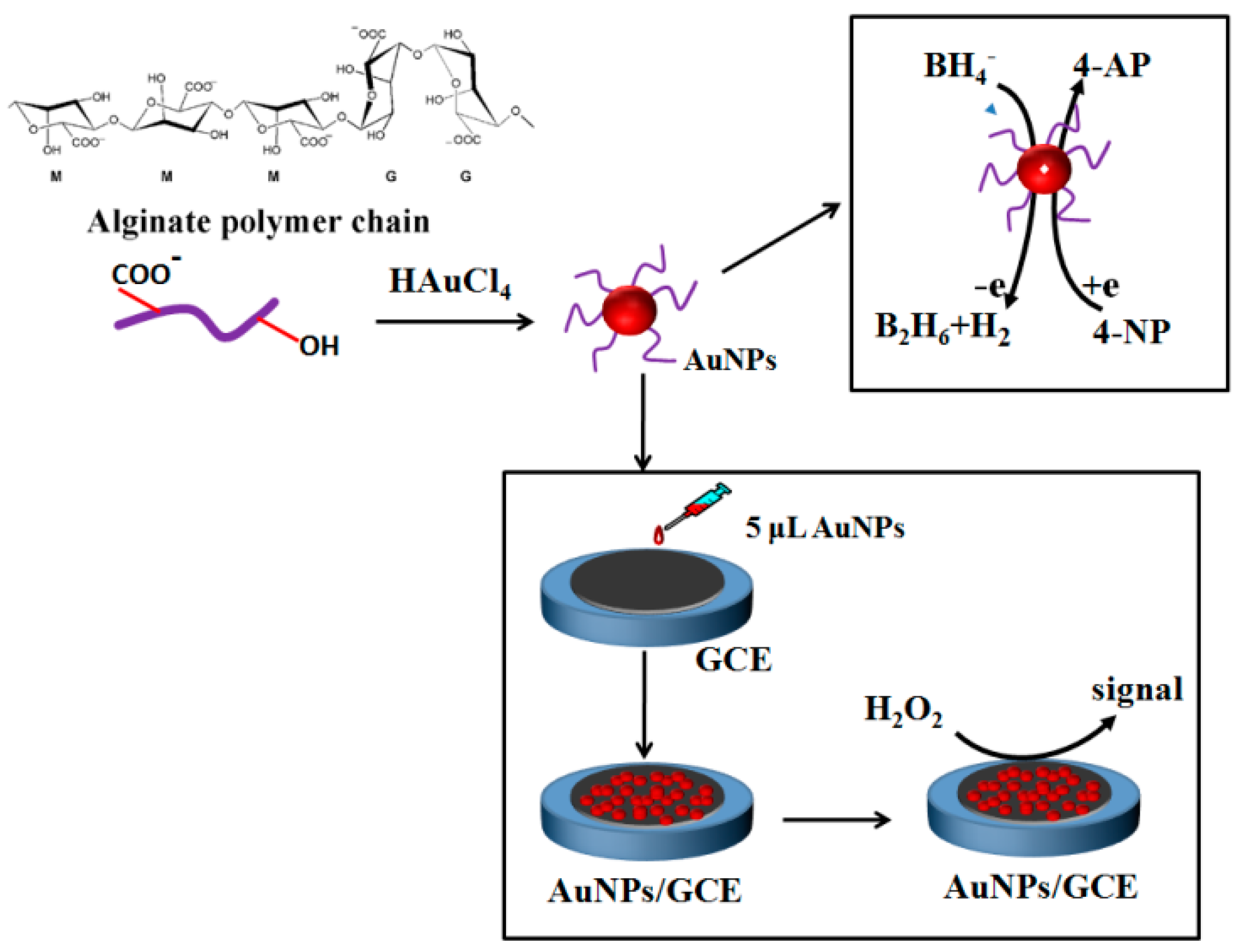

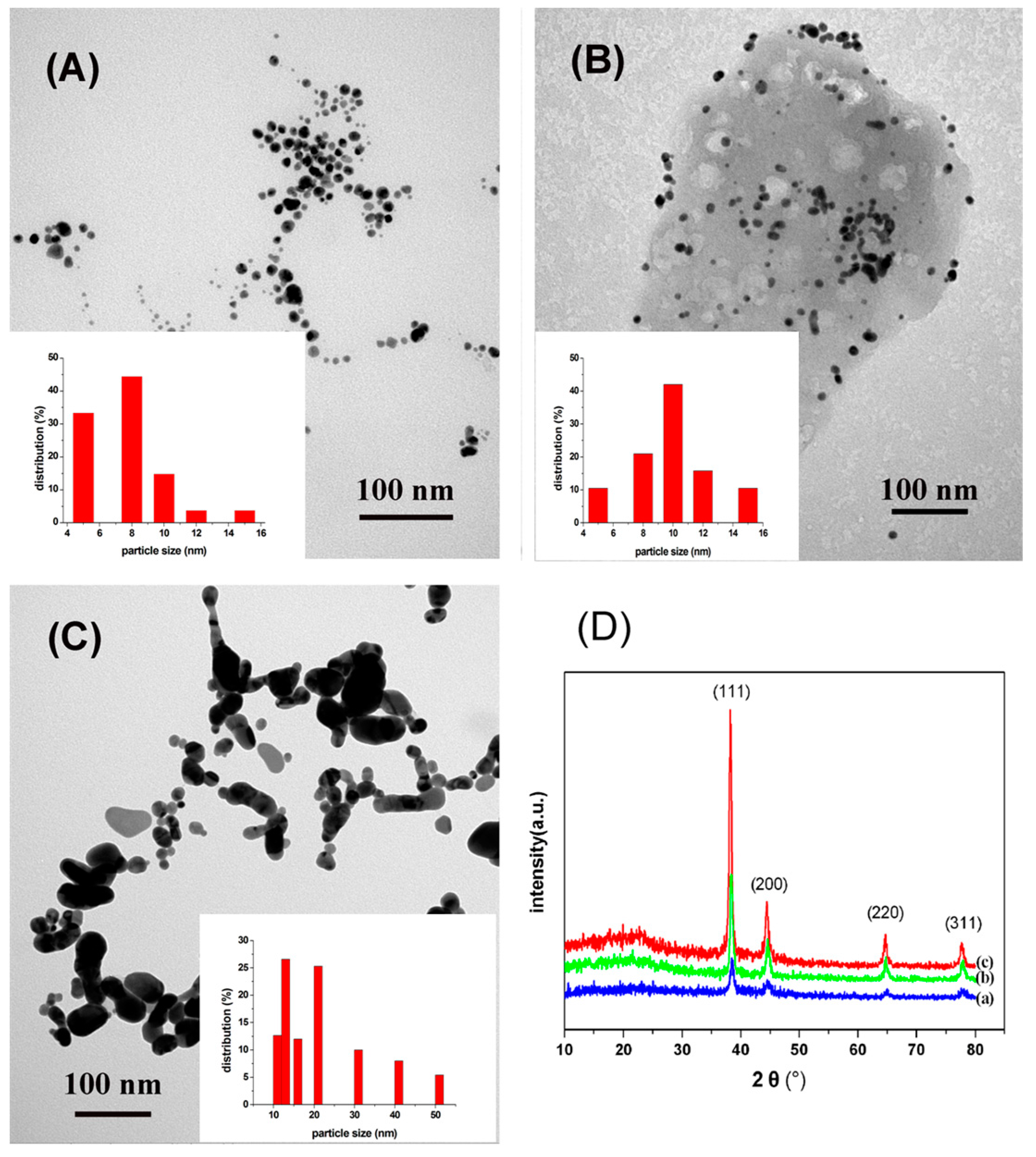
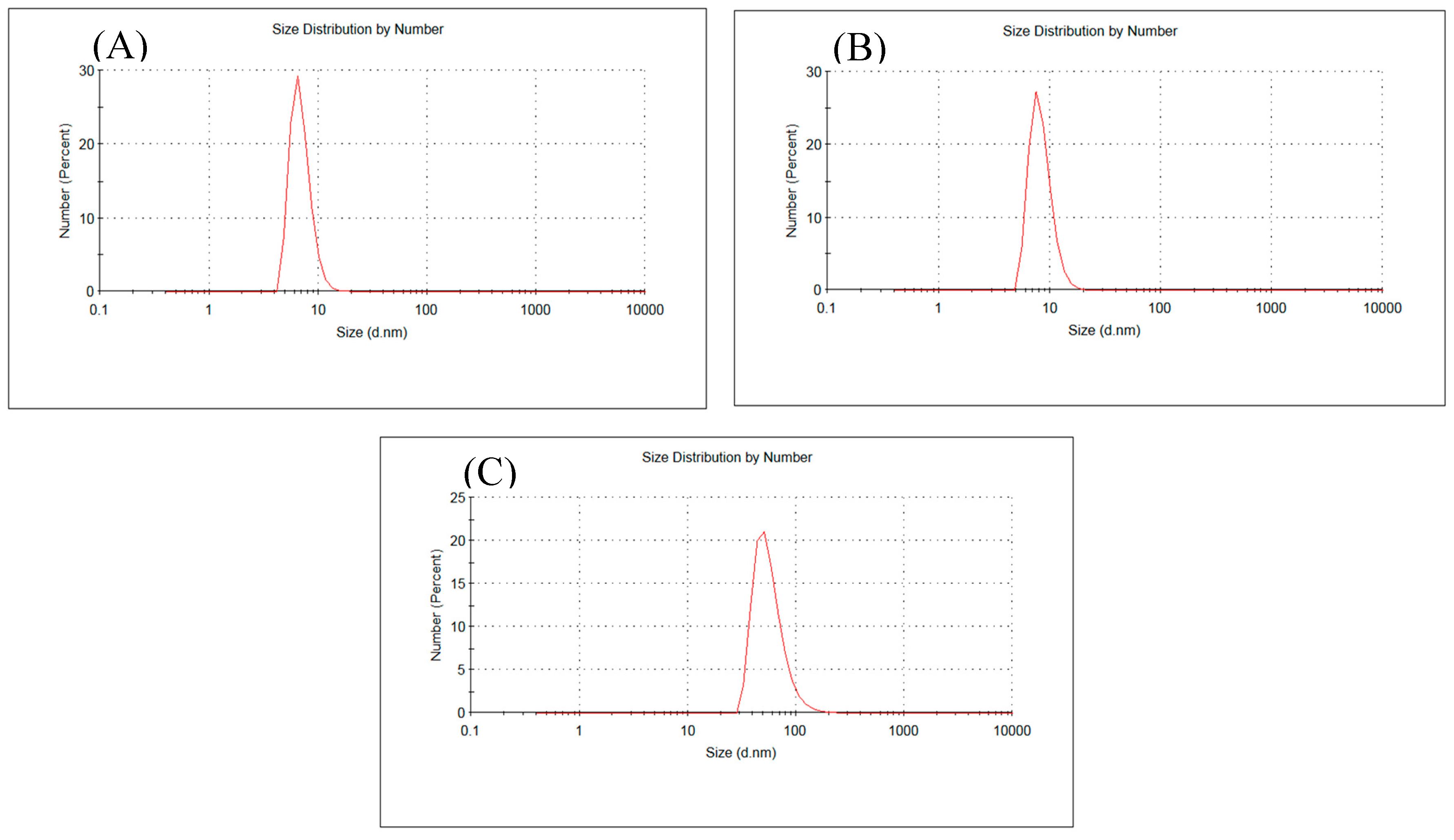
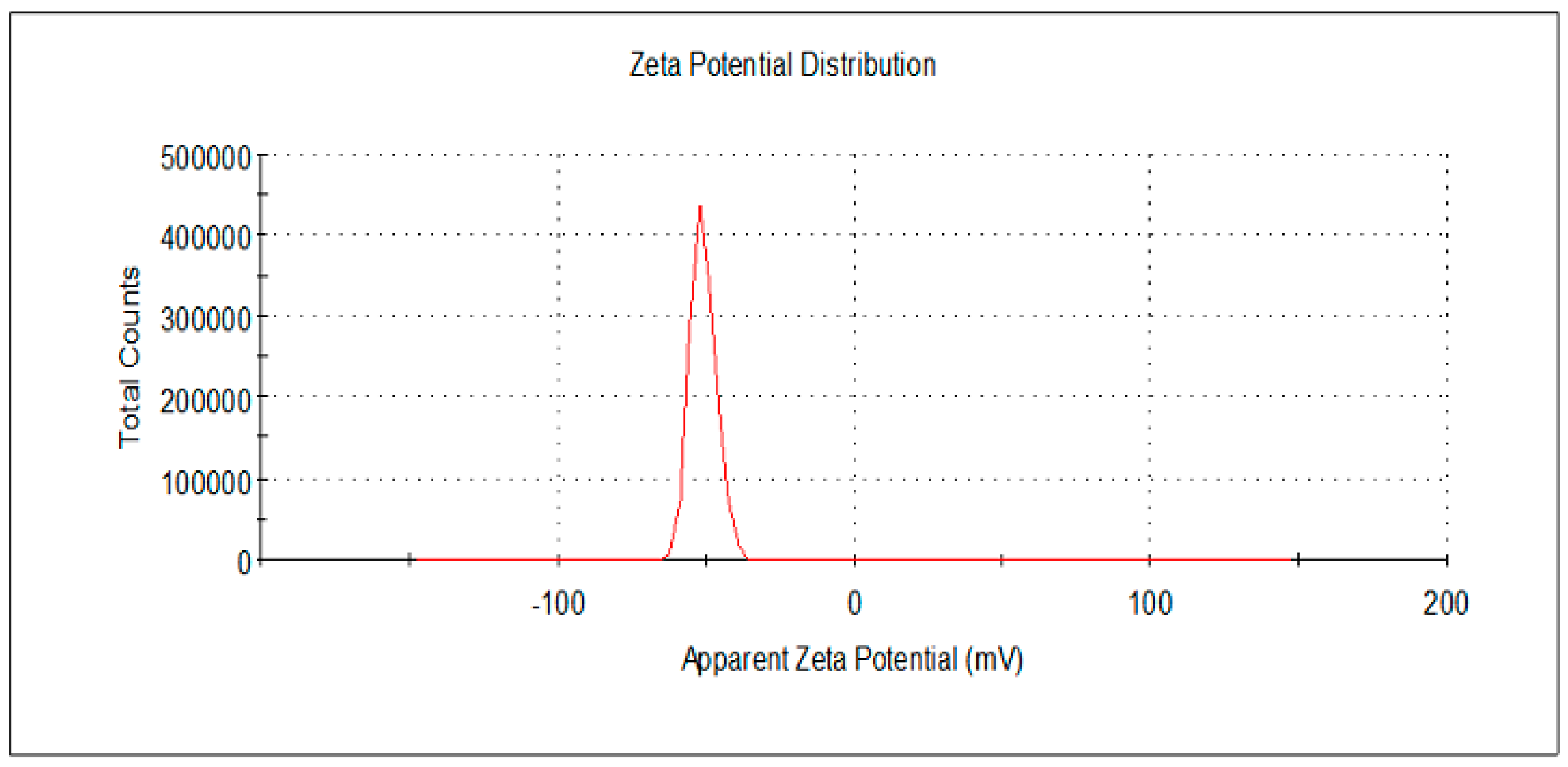


© 2017 by the authors. Licensee MDPI, Basel, Switzerland. This article is an open access article distributed under the terms and conditions of the Creative Commons Attribution (CC BY) license (http://creativecommons.org/licenses/by/4.0/).
Share and Cite
Zhao, X.; Li, Z.; Deng, Y.; Zhao, Z.; Li, X.; Xia, Y. Facile Synthesis of Gold Nanoparticles with Alginate and Its Catalytic Activity for Reduction of 4-Nitrophenol and H2O2 Detection. Materials 2017, 10, 557. https://doi.org/10.3390/ma10050557
Zhao X, Li Z, Deng Y, Zhao Z, Li X, Xia Y. Facile Synthesis of Gold Nanoparticles with Alginate and Its Catalytic Activity for Reduction of 4-Nitrophenol and H2O2 Detection. Materials. 2017; 10(5):557. https://doi.org/10.3390/ma10050557
Chicago/Turabian StyleZhao, Xihui, Zichao Li, Yujia Deng, Zhihui Zhao, Xiaowen Li, and Yanzhi Xia. 2017. "Facile Synthesis of Gold Nanoparticles with Alginate and Its Catalytic Activity for Reduction of 4-Nitrophenol and H2O2 Detection" Materials 10, no. 5: 557. https://doi.org/10.3390/ma10050557





